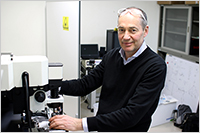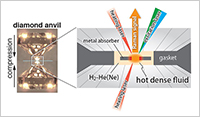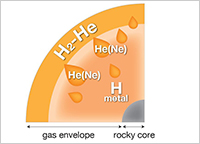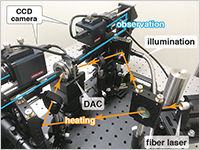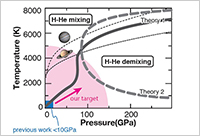Division for Basic Planetary Materials Science
Institute for Planetary Materials, Okayama University, Misasa, Tottori.
Enlarge Image Figure 1. The Diamond-Anvil Cell (DAC). [Left] Gem-quality diamond anvils used to create high pressure and temperature in the laboratory. [Right] A cross-section of the trapped sample showing confining gasket and heating (pump laser and diagnostic Raman excitation laser. A metal absorber, with a hole 1/5 size of a human hair, will be used to heat the a dense fluid of hydrogen mixtures representative of Jupiter’s shallow interior.
Enlarge Image Figure 2. A cross-section of a “typical” gas giant planet. For Jupiter the mean radius is ~70,000 km, approximately 11 times the size of Earth. The Galileo probe in 1996 revealed unexpected neon depletion in the atmosphere. One explanation that needs to be tested is that neon alloys with helium and “rains out” of a metallic hydrogen layer, somewhere within Jupiter’s (and Saturn’s) interior.
Enlarge Image Figure 3. The optical components of the laser-heating system for the DAC at IPM showing the 200W infra-red fibre laser source operating at 1070nm (orange) and the beam path of collected light (blue) for Raman scattering and imaging.
Enlarge Image Figure 4. There are different predictions for position of the P-T envelope where hydrogen and helium “de-mix” with pressure and temperature (see Ref. 2). In the DAC, only a small region of the hydrogen-helium phase diagram has been explored so far (dark blue square). With new static methods for generation of P and T in the DAC we hope to extend the range studied by perhaps an order of magnitude (pink region) toward the predicted “de-mixing” boundaries (solid and dashed grey curves).
Enlarge Image
Planetary science: Extreme heat and pressure to yield unique insights into the origin of gaseous planets
Okayama University’s Institute for Planetary Materials (IPM) is one of the world’s premier institutes conducting fundamental research on planetary systems science. Its mission is to integrate solar system studies for better understanding of the distribution, origin and interaction of planetary materials, including the origin of life.
Laser-Heated Diamond-Anvil Cell (DAC)
Andrew Jephcoat is at the Division for Basic Planetary Materials Science and leading IPM’s research on the evolution of the solar system with laboratory studies recreating the extremes of pressure (P) and temperature (T) existing in the deep interiors of planets.
Over the years, diamond-anvil cells (DAC’s) have been widely used to reproduce the environment at core of the Earth for example, with high temperatures and pressures up to 1000’s of degrees and over 300 GPa.
Mysteries of “gas giant” planets
Recently, however, the target of high P-T research has shifted to investigating the interior of so-called ‘gas giants’ like Jupiter and Saturn. Notably, stars and the universe consist mainly of hydrogen (H2) and helium (He), and it is thought that the high temperature and high pressure regions inside such planets are composed of mainly these hot, dense fluids, surrounding a small rocky, possibly solid core, itself at ultrahigh pressure and temperature (Figure 2). There are still many uncertainties about the compositional changes in these molecular fluid planetary envelopes under extremes of P and T.
For example, the Galileo entry probe (7/12/95) sampled Jupiter’s atmosphere and revealed unexpected depletion of the trace rare gas neon (Ne). Theoretical models recently predicted (Refs. 1,2) that hot, dense helium fluid could separate from fluid metallic hydrogen in the deep interior of the gas giants, forming “hot helium rain” and dragging neon preferentially dissolved within it to deeper regions of the planet (Figure 2). In addition, the observed excess luminosity of Saturn for its current age, might also result from the additional gravitational internal energy source that such helium segregation could provide. “We need to begin to try to observe this process and other possible molecular reactions that are important to gain insights into the interior structure of such planets.”
Aims and approach of research using diamond anvil cells at IPM
The IPM group are designing experiments (Figure 3) on the H2-He-Ne system for up to 200 GPa-6000 K (much higher than previous experiments at 10 GPa-500 K) to try to observe the behaviour by making measurements using laser Raman scattering with the DAC. “These experiments are challenging because hot hydrogen is extremely reactive and difficult to confine, diffusing into the diamond anvils.” “If we can hold P and T steady for long enough, we might observe this elusive phase separation.” (Figure 4.) Our work under static conditions compliments transient laser-shock experiments on pre-compressed He-H2 targets.
Plans and expectations
Since July 2016 NASA’s JUNO spacecraft has been mapping Jupiter’s magnetic and gravitational fields in order to understand better its interior structure, core mass, and origin of the magnetic field. Clarifying the correlation and behavior of H-He mixtures with other trace molecular species mixtures at even moderate depths, is expected to be a major advance in understanding the interior and chemical composition of Jupiter and Saturn. These DAC methods can be applied to a range of planetary materials, including organics and water and will add to accumulated human knowledge on the origin of planets and other solar-system bodies.
This is an epic project to unlock the secrets of origin of Jupiter and other planets in the solar system.
Ref. 1 Wilson, H. F & B. Militzer, Sequestration of noble gases in giant planet interiors, Phys. Rev. Lett., 121101 (2010).
Ref. 2. Morales, M. A., S. Hamel, K. caspersen & E. Schwegler, Hydrogen-helium demixing from first principles: From diamond anvil cells to planetary interiors, Phys. Rev. B., 87, 174105 (2013).
Further information
- IPM website
http://www.misasa.okayama-u.ac.jp/eng/ - Nasa website
https://www.nasa.gov/mission_pages/juno/overview/index.html - Okayama e-Bulletin vol.11 June 2015
http://www.okayama-u.ac.jp/user/kouhou/ebulletin/pdf/vol11.pdf

